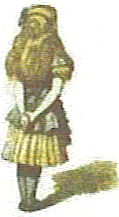
Imagine in an "action of a kind" you start off from one place. A photon travelling through a slit of Thomas Young's, to get through "a world" to the other side. Sounds like some fairy tale doesn't it? Yet, "the backdrop" is where you started?

Thomas Young (June 14, 1773 – †May 10,1829)was an English scientist, researcher, physician and polymath. He is sometimes considered to be "the last person to know everything": that is, he was familiar with virtually all the contemporary Western academic knowledge at that point in history. Clearly this can never be verified, and other claimants to this title are Gottfried Leibniz, Leonardo da Vinci, Samuel Taylor Coleridge, Johann Wolfgang Goethe and Francis Bacon, among others. Young also wrote about various subjects to contemporary editions of the Encyclopedia Britannica. His learning was so prodigious in scope and breadth that he was popularly known as "Phenomenon Young."
Simplistically this "
massless entity" is affected by the "geometrics of gravity?" Is affected from it's "first light." All the way to some "other point in reality" to some image, called the spectrum.
I am dreaming. I am walking down the street and there is this "N category cafe."
Imagine walking off the street into this very public venue and seeing the philosophy shared is also held to certain constraints. :)Philosophy? Yes, we all have our "points of view."
Travelling the Good Life with EaseSo in this travel how is one to see this "curve of light" or "slide" and we get this sense of what gravity can do.
Imagine indeed, "a hole cosmological related" in the
three body problem, it has to travel through, and we get this sense of "lensing and distortion," abstractually gravitationally induced?

So as we look at the cosmos what illusion is perpetrated on our minds as we look into the "great distance of measure" that somehow looking to the journey of "an event local," from our place on and about earth, has not been "chaotically entrained in some way, as we look deep into space?

The Magic SquarePlato:Like Pascal, one finds Albrecht has a unique trick, used by mathematicians to hide information and help, to exemplify greater contextual meaning. Now you have to remember I am a junior here in pre-established halls of learning, so later life does not allow me to venture into, and only allows intuitive trials poining to this solid understanding. I hope I am doing justice to learning.
Moving in abstract spacesIt was necessary to explain why I added "the image" to the right in my index.
Some would think me so "esoteric" that I had somehow lost touch with the realities of science? That to follow any further discussion here "has to be announced" to save one's dignity? What ever?:)I am esoteric in that my views of the world come from a different place, not unlike your expression of where you had come from living your life. How would I come to know all that you are in a "single sentence." A single and very short equation? It's really not that easy is it?:)
So I read you from all the things that you say and get the sense of who you are no different then what is implied in the language of poetic art implied carefully from choosing your words?
Artistically Inclined?I tried to give some hint of the "ideas floating" around in my head. I understand quite well that my challenge has been to get those "images in my head" transmitted onto paper, in a way that one would not become confused as to what is being implied.
So a good writer I may not be, a "not so good scientist" whose mathematics very ill equipped.
Thus I am faced with these challenges in the new year? A "recognition" of trying to produce that clarity. Whether in "latex" the symbols of mathematics, it is quite a challenge for me, whilst all these things are still engaged in abstract views of reality.
So someone like Clifford, may look at
Robert by what he has written and say, "hey, my fellow scientists are indeed in trouble" from what Robert has learnt. So I Clifford will provide "
the latex sandbox" for you to play in?
It "appears" I am not alone. My struggle, are to be many a struggle.
Art and the AbstractBut to my amazement this morning in checking up the links associated of Clifford's, I was amazed to see the article of,
Hooking Up ManifoldsNow how interesting that what is being displayed there in terms of fun, mathematics, art, could have been so abstractly appealing? "Moving over these surfaces" in ways that one might never appreciated, had you not known about how one can look at the universe in the "two ways mentioned previously," and by simple experiment, transcend such things to art.



